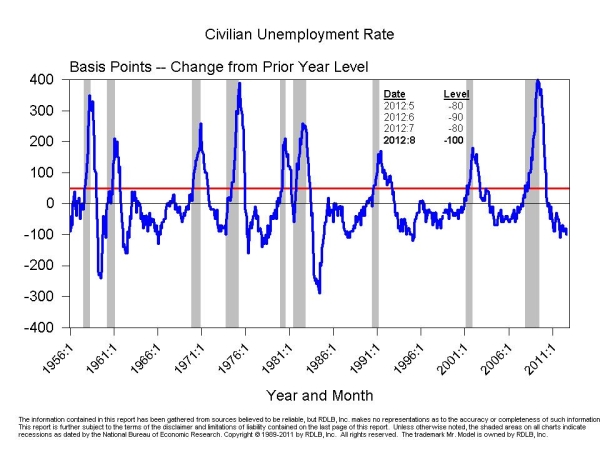In an earlier post we showed you an indicator from the Establishment Survey with an impeccable record of indicating where we should look for business cycle turning points. Here’s one from the Household Survey that meets the same standard.
We recently showed you a chart based on the Nonfarm Payroll data that has helped us navigate the twists and turns of the business cycle. We would now like to show you one that is based on the Unemployment Rate that does the same thing.
 The points plotted on this chart were calculated by taking the difference between the level of the Unemployment Rate in any given month and the level of the Unemployment Rate in the same month one year prior. So, for August 2012, the latest point plotted, you see -100 Basis Points. This was because the Unemployment Rate in August 2012 was 8.1% and the Unemployment Rate in August 2011 was 9.1%. The difference -1% is equal to -100 Basis Points. Like its counterpart from the Establishment Survey, this chart has several charming and endearing qualities.
The points plotted on this chart were calculated by taking the difference between the level of the Unemployment Rate in any given month and the level of the Unemployment Rate in the same month one year prior. So, for August 2012, the latest point plotted, you see -100 Basis Points. This was because the Unemployment Rate in August 2012 was 8.1% and the Unemployment Rate in August 2011 was 9.1%. The difference -1% is equal to -100 Basis Points. Like its counterpart from the Establishment Survey, this chart has several charming and endearing qualities.
First, it makes sharp turns at the ends of the recessions, after rising steadily in the recession. The only thing we like better than a “V” shaped bottom, is and inverse “V” top.
Second, it smoothly transits through the +50 Basis Point level at, or near, the start of a recession. You will note that while there are several cases of the line going through zero from below without there being a recession, there are no cases of the line going through +50 without there being a recession.
Third, as was the case with the other chart, the time scale on this one also goes back to 1956.
As you know I don’t think we are in a recession, unlike a fairly large cohort of commentators out there. When asked why, I show them this chart. And, while I am the first to admit that times have changed and that we may be looking a “new” normal, I don’t think times have changed to such a degree that this chart is telling us anything other than what it has told us previously. We are not now in the configuration we associate with the onset of a business cycle peak.